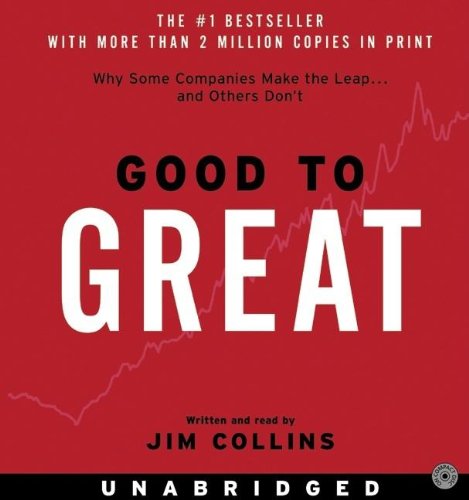
Built To Last, the defining management study of the nineties, showed how great companies triumph over time and how long-term sustained performance can be engineered into the DNA of an enterprise from the very beginning.
But what about companies that are not born with great DNA? How can good companies, mediocre companies, even bad companies achieve enduring greatness? Are there those that convert long-term mediocrity or worse into long-term superiority? If so, what are the distinguishing characteristics that cause a company to go from good to great?
Over five years, Jim Collins and his research team have analyzed the histories of 28 companies, discovering why some companies make the leap and others don’t. The findings include:
Level 5 Leadership: A surprising style, required for greatness.The Hedgehog Concept: Finding your three circles, to transcend the curse of competence.A Culture of Discipline: The alchemy of great results.Technology Accelerators: How good-to-great companies think differently about technology.The Flywheel and the Doom Loop: Why those who do frequent restructuring fail to make the leap.Five years ago, Jim Collins asked the question, “Can a good company become a great company and if so, how?” In Good to Great Collins, the author of Built to Last, concludes that it is possible, but finds there are no silver bullets. Collins and his team of researchers began their quest by sorting through a list of 1,435 companies, looking for those that made substantial improvements in their performance over time. They finally settled on 11–including Fannie Mae, Gillette, Walgreens, and Wells Fargo–and discovered common traits that challenged many of the conventional notions of corporate success. Making the transition from good to great doesn’t require a high-profile CEO, the latest technology, innovative change management, or even a fine-tuned business strategy. At the heart of those rare and truly great companies was a corporate culture that rigorously found and promoted disciplined people to think and act in a disciplined manner. Peppered with dozens of stories and examples from the great and not so great, the book offers a well-reasoned road map to excellence that any organization would do well to consider. Like Built to Last, Good to Great is one of those books that managers and CEOs will be reading and rereading for years to come. –Harry C. Edwards

Eleven Enduring Great Companies: 15 Years from 1998 to 2013 “Good to Great” introduces readers to the concept of an enduring great company, one that sustains tremendous growth for at least 15 years from the so called “turning point”.Published in 2001, the book gives us a great opportunity to analyze how much endurance there is in a great enduring company.Since many of the graphs in the book end in 1998, let’s see how the eleven example companies listed in the book did in the next 15 years, from 1998 to 2013.If a…
Rare Pathways to Exceptionally Increased Prosperity This study was stimulated by Mr. Bill Meehan’s (head of McKinsey in San Francisco) observation that Built to Last wasn’t very helpful to companies, because the firms studied had always been great. Most companies have been good, and never great. What should these firms do?Jim Collins and his team have done an enormous amount of interesting work to determine whether a good company can be come a great company, and how. The answer to the former question is “yes,” assuming that the 11 of…